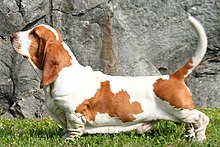Basset Hound
The Basset Hound is a short-legged breed of dog of the hound family, as well as one of six recognized Basset breeds in France; furthermore, Bassets are scent hounds that were originally bred for the purpose of hunting rabbits and hare. Their sense of smell for tracking is second only to that of the Bloodhound.[1] The name Basset is derived from the French word bas, meaning "low", with the attenuating suffix -et, together meaning "rather low". Basset Hounds are usually Bicolors or Tricolors of standard hound coloration.
Appearance
Bassets are large, short, solid and long, with curved sabre tails held high over their long backs. Everett Millais, founder of the modern Basset Hound, is quoted as saying "Oh, he's about 4 feet long and 12 inches high." in reference to his French basset. [a] An adult dog weighs between 20 and 35 kilograms (44 and 77 lb).
This breed, like its ancestor the Bloodhound, is known for its hanging skin structure, which causes the face to occasionally look sad; this, for many people, adds to the breed's charm. The dewlap, seen as the loose, elastic skin around the neck, and the trailing ears which along with the Bloodhound are the longest of any breed, help trap the scent of what they are tracking. Its neck is wider than its head. This combined with the loose skin around its face and neck means that flat collars can easily be pulled off. The previous FCI standard described the characteristic skin of the Basset, which resembles its ancestor the Bloodhound as "loose". This wording has since been updated to "supple and elastic".The looseness of the skin results in the Basset's characteristic facial wrinkles. The Basset's skull is characterised by its large Dolichocephalic nose, which is second only to the Bloodhound in scenting ability and number of olfactory receptor cells.
The Basset's short legs are due to a form of dwarfism (see: Health). Their short stature can be deceiving; Bassets are surprisingly long and can reach things on table tops that other dogs of similar height can not. Because Bassets are so heavy and have such short legs, they are not able to hold themselves above water for very long when swimming, and should always be closely supervised in the water.
History
The earliest-known depictions of short-legged hunting dogs are engravings from the Middle Kingdom of Egypt. Mummified remains of short-legged dogs from that period have been uncovered in the Dog Catacombs of Saqqara, Egypt. Scent Hounds were used for hunting in both Ancient Greece and Ancient Rome.
St Hubert's Hound
The basset type originated in France, and is descended from the 6th century hounds belonging to St Hubert of Belgium, which through breeding at the Benedictine Abbey of St. Hubert eventually became what is known as the St Hubert's Hound around 1000AD. St Hubert's original hounds are descended from the Laconian (Spartas) Hound,[13] one of four groups of dogs discerned from Greek representations and descriptions. These scent hounds were described as large, slow, 'short-legged and deep mouthed' dogs with a small head, straight nose, upright ears and long neck, and either tan with white markings or black with tan markings.[14] Laconian Hounds were reputed to not give up the scent until they found their prey. They eventually found their way to Constantinople, and from there to Europe.[13]
France
The first mention of a "basset" dog appeared in La Venerie, an illustrated hunting text written by Jacques du Fouilloux in 1585. The dogs in Fouilloux's text were used to hunt foxes and badgers. It is commonly believed that the Basset type originated as a mutation in the litters of Norman Staghounds, a descendant of the St Hubert's Hound. These precursors were most likely bred back to the St. Hubert's Hound, among other derivative French hounds. Until after the French Revolution around the year 1789, hunting from horseback was the preserve of kings, large aristocratic families and of the country squires, and for this reason short-legged dogs were highly valued for hunting on foot.
Basset type hounds achieved noticeable public cultural popularity during the reign of Emperor Napoleon III (r. 1852-1870). In 1853, Emmanuel Fremiet, "the leading sculptor of animals in his day" exhibited bronze sculptures of Emperor Napoleon III's basset hounds at the Paris Salon.[16] Ten years later in 1863 at the first exhibition of dogs held in Paris, basset hounds attained international attention.[17]
The controlled breeding of the short haired basset began in France in the year 1870. From the existing Bassets, Count Le Couteulx of Canteleu fixed a utilitarian type with straight front legs known as the Chien d'Artois, whereas Mr. Louis Lane developed a more spectacular type, with crooked front legs, known as the Basset Normand. These were bred together to create the original Basset Artésien Normand.[18]
England
French bassets were being imported into England at least as early as the 1870s. While some of these dogs were certainly Basset Artésien Normands, by the 1880s linebreeding had thrown back to a different heavier type. Everett Millais', who is considered to be the father of the modern Basset Hound, bred one such dog, Nicholas, to a Bloodhound bitch named Inoculation through artificial insemination in order to create a heavier basset in England in the 1890s. The litter was delivered by caesarean section, and the surviving pups were refined with French and English bassets. The first breed standard for what is now known as the Basset Hound was made in Great Britain at the end of 19th century. This standard was updated in 2010.
 | ||||||||||||||||||||||
| Tan and White Basset Hound | ||||||||||||||||||||||
| Nicknames | Basset, Hush Puppy | |||||||||||||||||||||
|---|---|---|---|---|---|---|---|---|---|---|---|---|---|---|---|---|---|---|---|---|---|---|
| Country of origin | Great Britain France | |||||||||||||||||||||
| ||||||||||||||||||||||
| ||||||||||||||||||||||
.



No comments:
Post a Comment